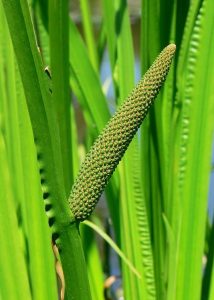Calamus
Home " Helophytes " Calamus
Plant filter with Calamus. Perfect for phosphate removal.
Calamus is a fairly well-known marsh or riparian plant that is regularly used in the pond or in a helophyte filter. The reason is that applying this plant is an efficient way to remove nutrients from the water. An excess of nutrients (nitrate, phosphate) can cause a major algae explosion in your pond, turning the water as green as grass. Of course, nobody wants that. Whereas the Yellow Lis is known for its nitrate-removing qualities, for phosphate removal you need Calamus. Like other helophytes, this riparian plant creates large root systems, allowing effective filtration.

Calamus in a helophyte filter
Calamus, as mentioned, is often used in a plant filter or helophyte filter. Such a plant filter simply means that the pond water flows past the roots of the plants, which thus remove dissolved nutrients from the water. In this way, much less is available for the algae in the pond, keeping the water clear. A helophyte filter or plant filter is very well suited for use in swimming ponds or koi ponds that prefer not to grow aquatic plants.
Also in the pond, calamus is great for phosphate removal. In addition, this marsh plant gives off a delicious, spicy fragrance, smelling somewhat like Berenburger. You can easily plant calamus in a pond basket. This can be done with substrate, but also with lava pebbles, for example. In solid soil is of course also possible!
Distribution and growth habit of calamus in the Netherlands and Belgium
Acorus calamus as this riparian plant is called in Latin, can be found wild along ditch banks and other water bodies in many places in Europe. Originally from Southeast Asia, it was imported to Europe as early as the 16th century and spread that way.
Plant height
Calamus grows between 60 cm and 110 cm high. It does not really flower in the Netherlands and Belgium, although a cob does form.
Planting depth
The planting depth for Calamus is around 5-15 cm, this gives the best growth for this marsh plant.
